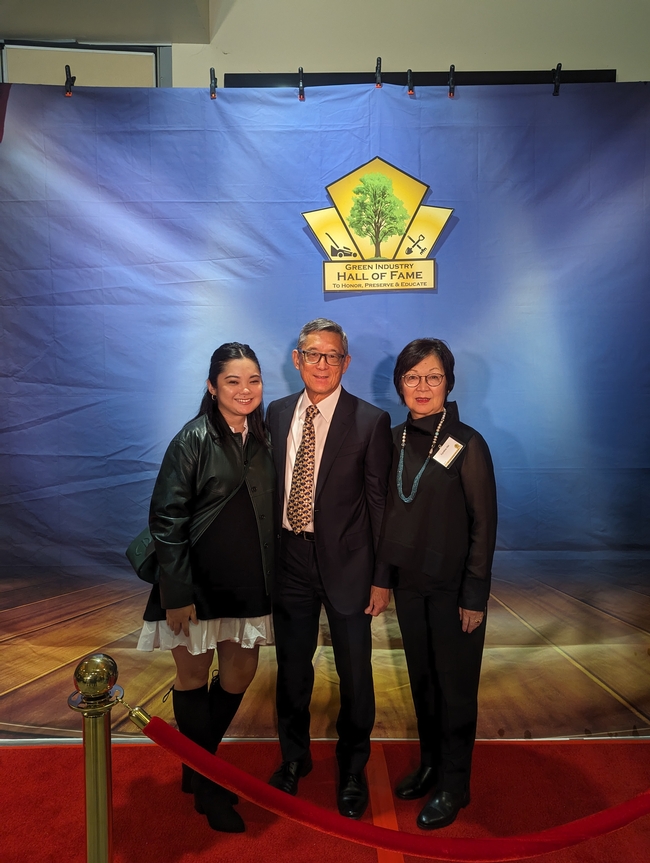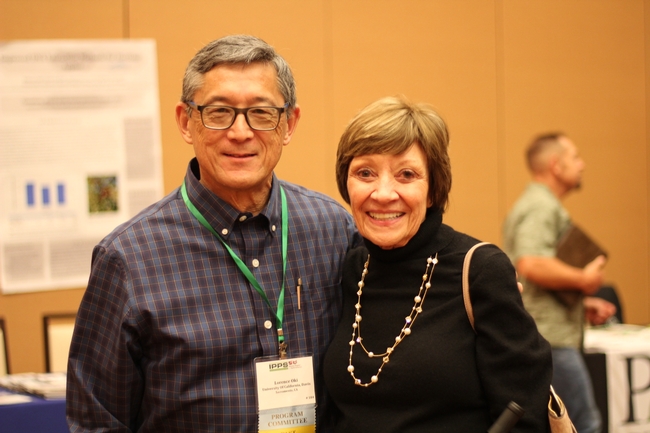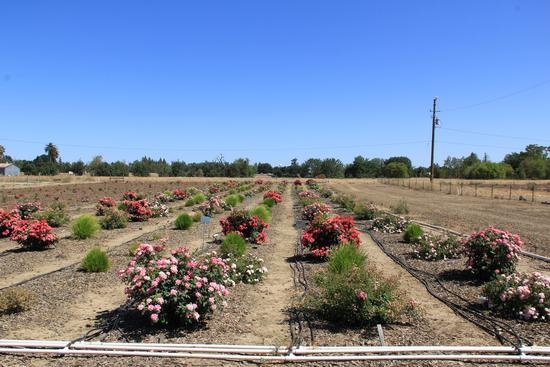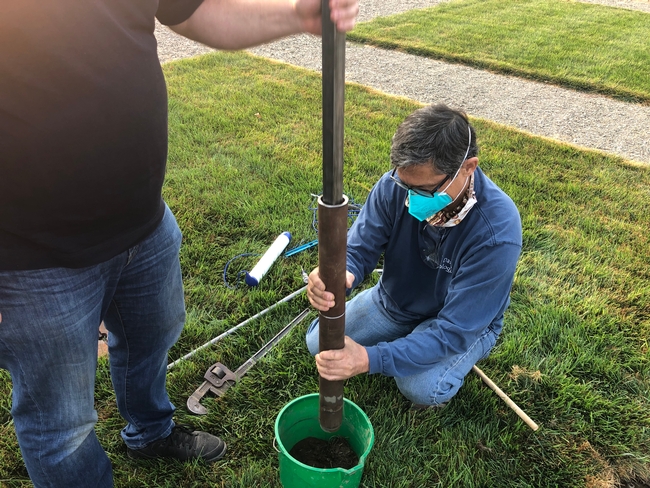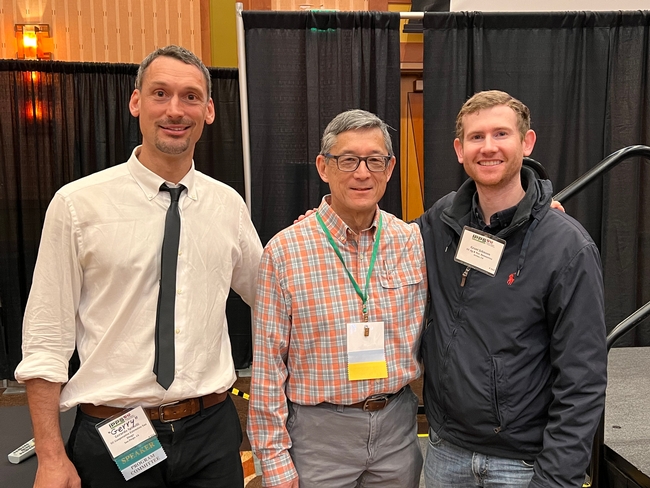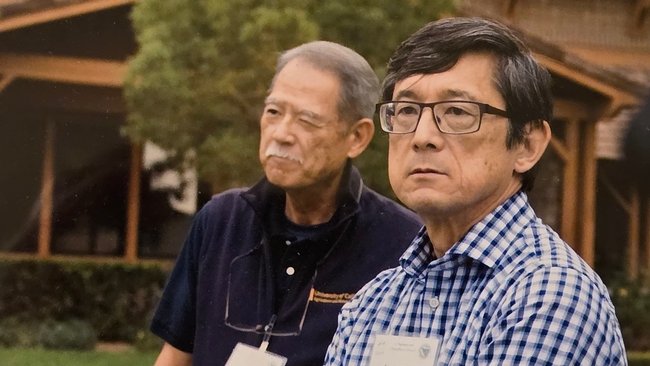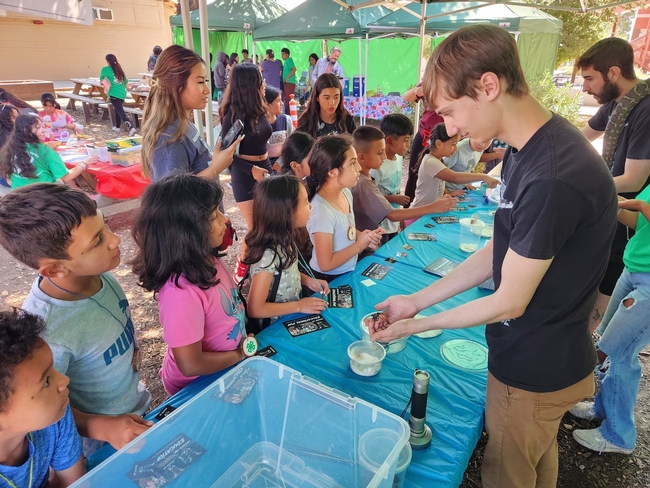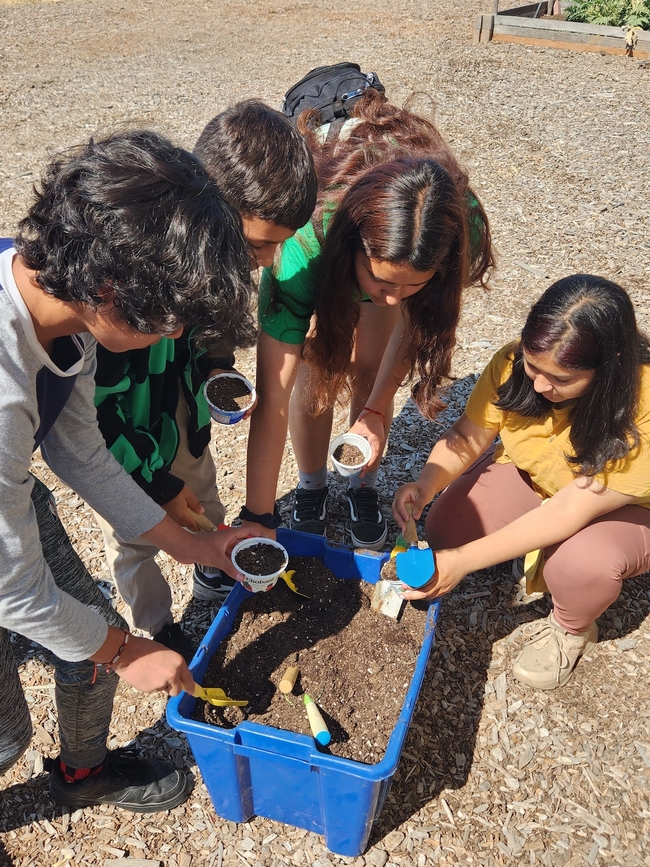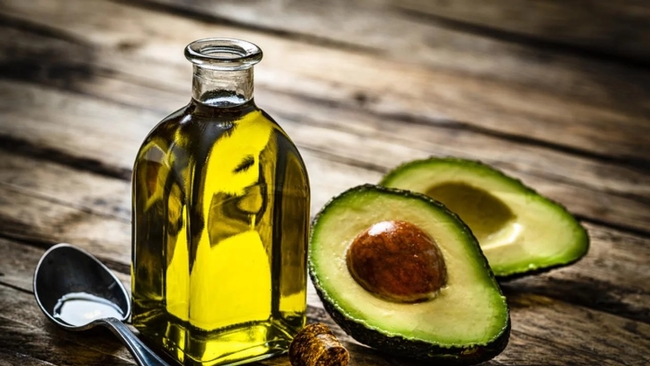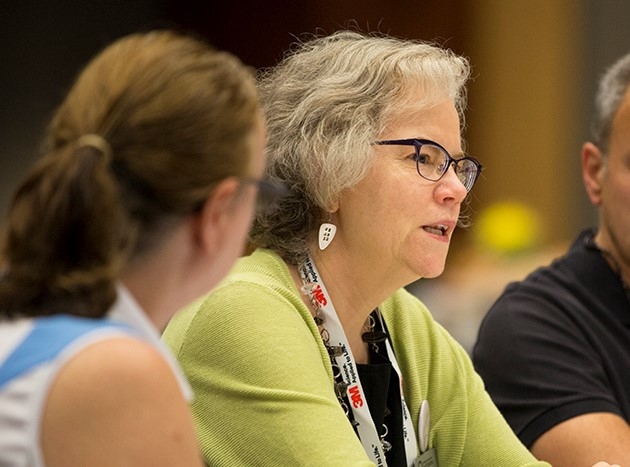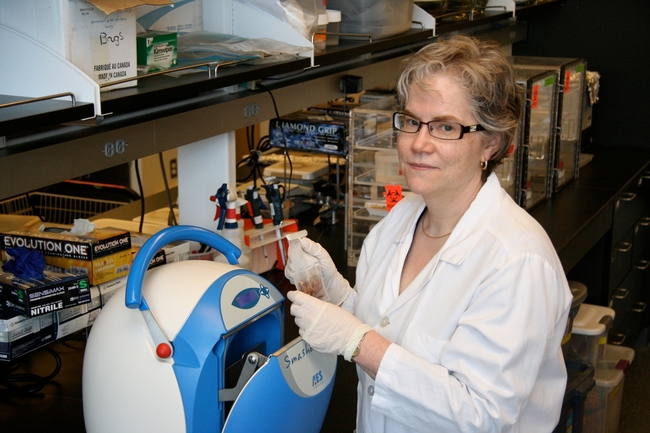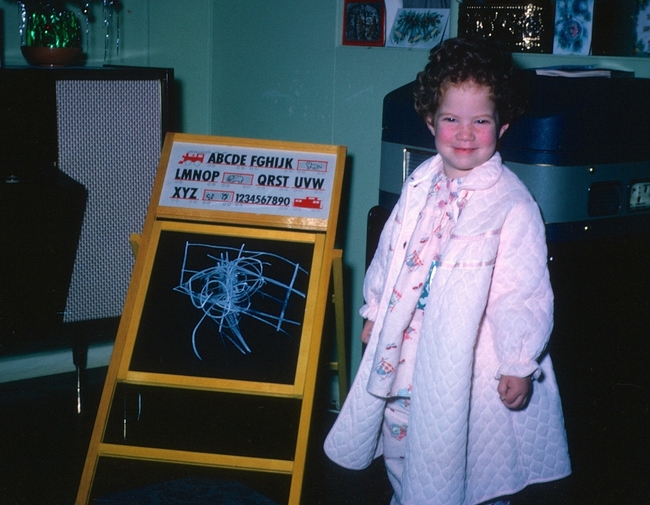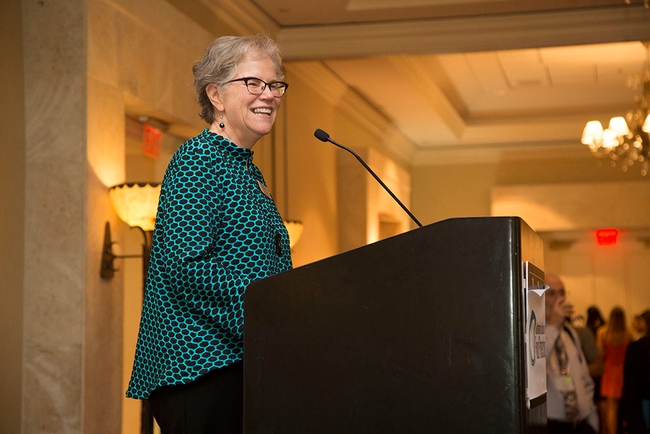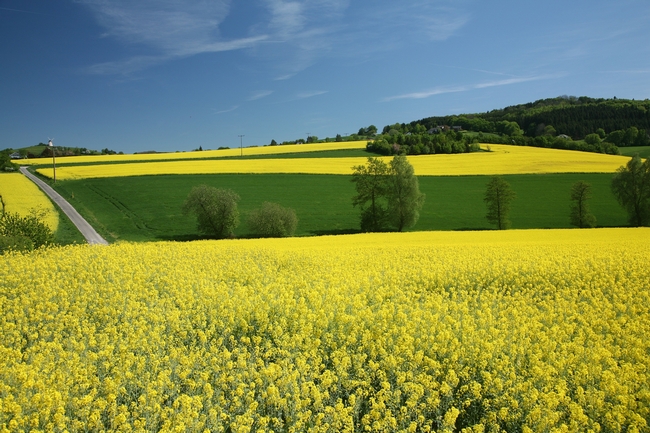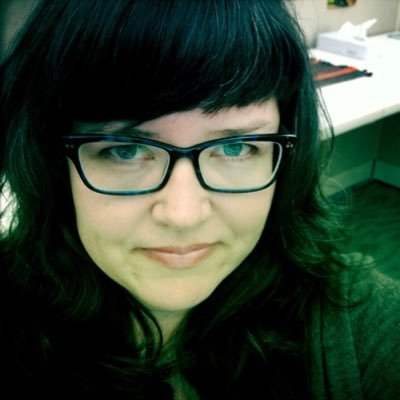Posts Tagged: science
Green Hall of Famer Oki retires after 29-year UC career
UCCE specialist's research prevents water pollution, reduces water use
When interviewed to become a University of California Cooperative Extension specialist in environmental horticulture, Lorence “Loren” Oki was asked what kind of research he wanted to conduct.
In response, he showed the hiring committee a photo of a residential gutter. “Water is a big concern, and I found very little research on runoff from homes,” said Oki, explaining that studying residential runoff is what “started his career” with UC Agriculture and Natural Resources back in 2002.
Although he remains active supporting growers and advising industry leaders, Oki retired from UC ANR in July 2023. Before joining ANR, Oki worked as a researcher for UC Davis' Department of Environmental Horticulture studying greenhouse irrigation in 1994, bringing his total time with the University of California to 29 years.
Oki, professor emeritus of Cooperative Extension at UC Davis, led many research projects that advanced the green industry which includes landscapes, nurseries and floriculture.
“Loren is the epitome of a specialist,” said Darren Haver, UC ANR's Research and Extension Center system director, who has worked with Oki for more than 20 years on projects that have significantly improved urban water quality and water conservation efforts across California.
Research influences pesticide management statewide
With a $3 million grant funding a statewide study, Oki and Haver set out to characterize runoff from residential sources over a five-year period. They determined the volume of irrigation runoff from residential land use, as well as the pollutants in the runoff.
Oki and Haver, co-principal investigators, along with researchers from UC Davis and UC Riverside, discovered that the degradation products of the insecticide fipronil – commonly found in runoff water – were more toxic than its parent compound. The study led to an investigation of human pathogens and pathogen indicators in residential runoff, the first of its kind.
Another contribution was the early detection of a new pesticide used for ant control, enabling strategies to be put in place to prevent it from reaching local streams and creeks. Oki and Haver's work also persuaded the California Department of Pesticide Regulation to change pesticide labels to minimize the chances of pesticides moving off target during irrigation and rain events.
These changes included preventing pesticide application before predicted rain and preventing irrigation after applications, keeping pesticides from impervious surfaces, and restricting applications on lawns and landscape beds within two feet of impervious surfaces and others.
Plant trials expand beyond California
Oki was also the principal investigator of the Climate-Ready Landscape Plants project, which may be the largest irrigation trial in the western U.S., and the UC Plant Landscape Irrigation Trials, the California component of that project. The UCPLIT trials originated in 2004 at UC Davis as a research project by Karrie Reid, retired UCCE environmental horticulture advisor for San Joaquin County, while she was pursuing her master's degree. In 2017, the irrigation trials were duplicated at the South Coast Research and Extension Center.
These projects evaluate landscape plants under varying irrigation levels to determine their optimal performance in regions requiring supplemental summer water. Throughout the trial, Oki identified many landscape plants, including rose cultivars, that remain aesthetically pleasing with little water.
Today, the trials have expanded beyond California as the Climate-Ready Landscape Plants Project at Oregon State University, University of Washington, University of Arizona and Utah State University.
Growing up in the nursery industry
In 2017, Oki obtained tenure, allowing him to expand his professional responsibilities to include production horticulture, specifically greenhouses and nurseries, an industry he was extremely familiar with. “I come from a nursery family,” Oki explained. “My grandfather started Oki Nursery in the early 1900s.”
During World War II, Oki's family was incarcerated in the Poston Relocation Center in Arizona and lost their homes and property. When they were released, they returned to the nursery industry to rebuild their lives. “After World War II, my father and uncle got more involved with my grandfather's work,” he said.
The Oki family played an instrumental role in technological development for nurseries in general. Oki Nursery, which was located in Sacramento, worked closely with IBM and was the first to use a computerized system in the industry.
Oki developed computerized scheduling for the bedding plants, poinsettias, chrysanthemums, bulbs and other crops. He developed a method to calculate the cost of any crop grown by the nursery at any point in the crop cycle and computerized greenhouse environmental and irrigation controls. This may not sound impressive now, but that was in the 1980s.
“My father was known for being progressive and he also knew everyone at UC Davis,” said Oki. “He wanted to work with anyone who had an interest in doing something good for nurseries.”
Inducted into Green Industry Hall of Fame
In the 1950s, Oki Nursery partnered with researchers from UC Davis' agricultural engineering program and developed the overhead sprinklers commonly used in nurseries today. Until the 1980s, Oki Nursery was the largest nursery in Northern California. Before it shut down in 1993, Oki worked in the family business as a greenhouse manager when runoff became a growing concern.
“I remember getting served with a notice by the Regional Water Quality Control Board stating that we needed to prevent runoff because it was polluted with nitrate fertilizer, which was common in the nursery industry,” Oki said.
One of those efforts focused on using controlled-release fertilizer instead of applying fertilizer via irrigation as a liquid feed. “What we learned is that if we converted nurseries to controlled-release fertilizer, we could reduce the nitrate runoff,” he said. While a member of the Oki Lab, Bruno Pitton earned his Ph.D. studying nursery hydrology and the fate of nitrogen fertilizers in container crop production adding to the information on runoff and nitrate management. Pitton is now the environmental horticulture advisor for Placer and Nevada counties.
In 2023, Oki was inducted into the Green Industry Hall of Fame, which recognizes individuals with a minimum of 20 years in the landscape, nursery or floriculture industry and who have made significant contributions to the field.
Having grown up in the industry, Oki said that his father taught him to never be afraid to try new things. “If you think you have an idea that might work, do the best you can to make it work. If it doesn't work out, then it doesn't work out. And that's OK,” he said.
Revitalizing space for greater impact
This mentality encouraged Oki whenever tackling new tasks, like rebranding the California Ornamental Research Federation, a space for education and collaboration, as UC Nursery and Floriculture Alliance.
In 2009, Oki and David Fujino, executive director of the California Center for Urban Horticulture, became co-directors of CORF, which catered to the cut flower industry. At that time, Oki and Fujino realized that nurseries generated much greater revenue in the state than cut flowers.
“It was a strategic decision to change CORF to UCNFA, which included floriculture and nurseries in the name,” Fujino said. Combined, nurseries and floriculture have consistently placed in the top five agricultural commodities in the state.
When reflecting on their partnership, Fujino said that working with Oki was a “natural fit.” “I couldn't have asked for a better partner, a better colleague and, ultimately, a better friend to have my back and work side by side,” he added.
Since UCNFA's launch, the two have worked to maintain the group's impact by hosting “Ask your Advisor” webinars to connect advisors to growers, as well as co-hosting large-scale events such as the annual conference for the International Plant Propagators' Society — an organization focused on greenhouse and nursery production education — for the Western Region, which Oki's father helped establish in the 1960s.
Encouraging a return to education
Gerry Spinelli, UC Cooperative Extension production horticulture advisor for San Diego County and member of UCNFA's administrative committee, described those who have learned from Oki as his sons and daughters. “When I meet someone that's learned from Loren or worked with him, that person instantly becomes my friend. That's the kind of effect Loren has on us,” Spinelli said.
Grant Johnson, UC Cooperative Extension urban agricultural technology advisor for Los Angeles and Orange counties, credits Oki for his master's degree in horticulture from UC Davis.
“Loren gave me a lot of direction as far as career choices and research interests. He instilled in me a dedication to life-long learning, just like he continues to do,” said Johnson. Before Oki became his professor, Johnson worked with Oki as a staff research associate at the South Coast Research and Extension Center in Irvine.
Another influential person in Oki's life is John Kabashima, emeritus environmental horticulture advisor for UCCE Orange and Los Angeles counties and fellow Green Hall of Fame inductee. Like Oki, Kabashima grew up in the nursery industry.
Oki, who earned a bachelor's degree in ornamental horticulture from Cal Poly San Luis Obispo and a master's degree in plant science from UC Riverside, decided to pursue a Ph.D. in ecology at UC Davis with Kabashima's encouragement.
While Oki was still working in his family's business, Kabashima said that Oki relied on UC ANR researchers for scientific information and felt like Oki wanted to be one of them. “I told him that he's a good nursery guy, but he's a better scientist,” said Kabashima. “His heart is in science.”
The two began working together as soon as Oki became a graduate student and have been colleagues and friends for nearly 40 years. “My favorite response from Loren whenever people ask him a question is, ‘It depends,'” Kabashima said. “It always leads to people opening up and giving more context. That's what Loren does, he gets you to think.”
Latino students shine (and squeal) at 4-H Nature Explorers Day Camp
University of California Cooperative Extension, 4-H Youth Development Program in Santa Clara County partnered with multiple community organizations to hold a 4-H Nature Explorers Day Camp at Escuela Popular Bilingual Academy in East San Jose from July 17 to July 21.
Organizers wanted to reach more participants this year than they had in the inaugural 2022 camp, so they structured the program for different K-8 grade levels to attend on different days. 79 campers participated, which was a 130% increase over the number of campers last year.
“Everything we did during the week was focused on environmental science,” said Susan Weaver, 4-H Regional Program Coordinator. “We partnered with Project Learning Tree, UC Environmental Stewards, UC Master Gardeners and CalFresh Healthy Living, UC– as well as community agencies related to the natural environment.”
Numerous activities engaged the youths such as field trips; demonstrations; and sessions themed around trees as habitats, birds and bugs, and being “leaf detectives.” 4-H Adult Volunteer, Laura Tiscareno, took charge of the hands-on Project Learning Tree sessions. Craft time included making nature-themed wind chimes and spinning paper snakes.
Bilingual teen camp counselors guided small groups of students for the duration of the day camp. In situations where the adult facilitator did not speak Spanish, teens translated information into Spanish for students with less English confidence.
“These kids call me ‘teacher' and it's awesome,” said Rodrigo, one of the counselors. “The camp benefits me a lot because I connect with children and in the future, I can even be a teacher if I wanted to.”
Another counselor, Andrea, learned about communication. “It's a bit different with kids at different age levels,” she said. “Since we had kindergarten through eighth grade, we had to switch our tactics from grade to grade so that they would understand us and we'd be able to understand them. Also learning how to bond with them so that they would pay more attention.
One highlight of the week was a field trip for third through eighth graders to the Master Gardeners location at Martial Cottle Park, where students learned about vermicomposting and made their own individual countertop worm habitat and composter.
Campers especially enjoyed the interactive demonstrations. “My favorite part is going on all the field trips because we went to a garden, and we've been catching worms and doing stuff about worms,” said one student. “It's really fun going on trips.”
Another camper said, “Something I would like to change about camp is having more time here.”
The program culminated in a Nature Camp Festival at Escuela Popular in partnership with community agencies. Youth enjoyed games, meeting reptiles, outdoor science activities, arborist crafts, a “Rethink Your Drink” table to make a fresh fruit drink, tamales, a nacho bar and more.
Representatives from the Silicon Valley Wildlife Center discussed animals that live in local neighborhoods and how the Center supports people to keep the animals safe. Victor Mortari of Vexotic Me talked about and showed snakes, spiders, scorpions, and other creatures, making the kids squeal while learning about them. As a fun added bonus, 4-H Community Educator Zubia Mahmood arranged to have a local team come to teach soccer skills as a healthy living activity.
The event increased the youth's interest in environmental education and involved Latino youth and adults who are new to 4-H – representing a community that has not historically benefited from the 4-H program. The teen teachers also increased their leadership and career readiness skills; post-camp surveys showed that all the teen counselors see 4-H as a place where they can be a leader and help make group decisions. Some campers noted in the survey that they wanted the camp to be every day, all summer!
National 4-H funded the camp in 2022 and 2023, allowing organizers to provide meals, T-shirts, water bottles and other items to foster belonging and promote healthy living. Community partners, crucial to the program's success, included the Boys and Girls Club of Silicon Valley, Escuela Popular Bilingual Academy, Silicon Valley Water and Silicon Valley Wildlife Center.

Teen counselors and campers working on a nutrition activity.
Nearly 70% of private label avocado oil rancid or mixed with other oils
Researchers identify key markers to help professional retail buyers choose authentic products
Avocado oil has become a popular choice for many people in recent years because of its heart-healthy benefits and versatility in cooking. However, not all avocado oil products on store shelves are created equal. Some products are labeled as “pure” avocado oil when they contain other oils or additives. No enforceable standards defining the chemical and physical characteristics of avocado oil exist yet.
Researchers at the University of California, Davis, analyzed samples of 36 private label avocado oil products and graded them based on quality and purity. Private label products are made by a third-party processor and sold under a grocery store or retailer brand label. Their findings, published in the journal Food Control, show that 31% of the samples tested were pure, and 36% were of advertised quality. Quality refers to whether the oil is fresh or has gone bad due to aging, heat or light exposure. For purity, researchers measured fatty acids, sterols and other components that differentiate avocado oil from other oils.
The study included oils purchased from 19 retailers in the U.S. and Canada with various price points. They found that lower-priced oils were more likely to be tainted with other oils.
“We found that low-cost products indicate a higher probability for adulteration, but high cost didn't guarantee purity or quality,” said Selina Wang, associate professor of Cooperative Extension in the Department of Food Science and Technology. She and Hilary Green, a postdoctoral researcher at UC Davis, co-authored the paper.
Researchers also identified certain chemical markers in avocado oil that professional retail buyers can use to make more informed decisions when it comes to choosing suppliers. This way, consumers can feel confident about the products they buy.
This is the second comprehensive study conducted by UC Davis researchers on the quality of avocado oil sold in the U.S. The first study released in 2020 found that many of the test samples were of poor quality, mislabeled or adulterated with other oils.
“This study demonstrates that although progress is being made in standard development since our first market study in 2020, there are still issues with purity in avocado oil and these issues extend significantly into private label oils,” Wang said.
Avocado oil standards
Since the release of the first UC Davis study, Wang said there's been a coordinated effort by researchers, industry leaders and government agencies to establish enforceable standards. The Avocado Oil Expert Group was formed in collaboration with the American Oil Chemists' Society to discuss potential standards and future research projects.
Wang's research group has been studying how natural factors like different types of avocados, harvest times, geographic origins and processing methods could affect the chemical composition of avocado oil. They want to create standards that will accommodate natural variations while detecting any adulterations.
Wang hopes that the study's findings will contribute to the establishment of standards that benefit both consumers and avocado oil producers who want to compete in a fair market.
“I'm very optimistic for the future of the avocado oil industry,” Wang said. “It's a high-value product with high consumer demand, similar to what I saw with olive oil 10 years ago. Olive oil quality and purity have improved significantly, which is where I see avocado oil going, if we can establish fair standards and eliminate fraudulent products.”
Five questions with food safety expert, new AAAS Fellow Linda Harris
Professor of Cooperative Extension shares career story, appreciation for UC Davis
After growing up in northern British Columbia, in a remote smelter town called Kitimat (“an 8-hour drive from the nearest McDonald's”), University of California Professor of Cooperative Extension Linda J. Harris embarked on an academic journey that crisscrossed North America and eventually led to her election as a Fellow of the American Association for the Advancement of Science.
AAAS, the world's largest multidisciplinary scientific society and publisher of the journal Science, recently announced the election of its 2021 class, which will be inducted during its annual meeting, Feb. 17-20.
In addition to Harris – a faculty member in UC Davis' Department of Food Science and Technology – four other UC Agriculture and Natural Resources affiliates will be inducted: Helene Dillard, dean of the UC Davis College of Agricultural and Environmental Sciences; Kathryn Uhrich, dean of the UC Riverside College of Natural and Agricultural Sciences; and UC Berkeley Professors Rodrigo Almeida and Paolo D'Odorico.
Harris, a Certified Food Scientist, recently shared her thoughts on the value of extension work, her contributions to the field, UC Davis' support for women in academia, and the arc of her career journey.
How did you get your start in food science and microbiology?
I was interested in science at an early age. As an undergraduate student at the University of Victoria in Victoria, B.C., I enrolled in biochemistry at the suggestion of my high school biology teacher. In my second year, I switched to the University of Alberta in Edmonton, Alberta and decided to review the course catalog – a paper version! When I got to the section on Food Science, the applied nature of the field just sounded right and I never looked back.
However, I didn't do particularly well in microbiology as an undergraduate student – too much memorization for me. At the end of my B.S. I was ready for a job in the food industry and took the very first job I was offered – ironically enough as a dairy microbiologist in a quality control lab. Thankfully, that job opened my eyes to the possibilities in microbiology. What was memorization turned into something I learned through doing and I was hooked.
Two years later, I was ready to go back to school and contacted a professor of food safety microbiology at the University of Alberta who fortunately had funding for me. During my M.S. degree in food microbiology, he encouraged me to pursue the Ph.D. – which was not something I had ever considered – and that led me to leave Canada and head to North Carolina State University and a Ph.D. in microbiology in the Food Science Department, where I worked on a project related to the fermentation of sauerkraut.
I did have one publication related to food safety during my time at NC State, and when I took my first faculty position back in Canada [University of Guelph in Ontario] I continued to work in food safety, mostly with meat and meat products.
I am so glad that I saw the advertisement for my current position and that I followed my instincts to apply for the job. The opportunities to grow professionally and to work in the food safety area at UC Davis, within the Cooperative Extension network in California, and with collaborators across the U.S., and around the world, have been enormous, and I am extremely grateful for the path that led me here.
February 11 is the United Nations-designated “International Day of Women and Girls in Science.” How has UC Davis supported women in your scientific field?
My career in STEM [science, technology, engineering and math] has been very rewarding and many of the gender barriers I faced early on have been addressed. I feel very fortunate to have landed at UC Davis and I am thankful that there is a long history of addressing these barriers at this institution.
When I was hired in 1996, the Department of Food Science and Technology was about 25% women and both the department chair and dean of the college were women. I had never been in a department or college with so many women faculty, including in positions of leadership. It was a very important consideration in my move. Today our department is 50% women and I proudly served for five years as the second woman department chair, from 2016 to 2021.
As a first-generation university graduate raised by a single mother, you have a unique perspective in encouraging young people on their path toward a STEM career. What advice do you have for them?
To those contemplating a career in STEM, I would say: be open to new opportunities and adventures – you never know where they may lead you. Get involved in leadership in any capacity you can from student organizations or around other things that interest you. Skills that you learn with these types of activities will be invaluable to your career.
I am very much an introvert and had to work hard to overcome my fear of public speaking. In addition to leadership roles in student clubs, I joined Toast Masters while working on my Ph.D. These activities had a huge impact on building my confidence and helped influence my career choices.
In the AAAS Fellows announcement, it says you were elected for “contributions to the field of food safety microbiology, especially related to control of Salmonella and other pathogens in low-moisture foods and fresh produce.” Is that your proudest achievement in the field?
I am most proud of the work described by that short statement especially as it applies to California-grown commodities. I would say that my laboratory is best known for work with the tree nut industry – almonds, pistachios and walnuts, as well as a range of types of fresh produce grown in this state.
My laboratory has worked to understand behavior, movement, prevalence, and especially control of foodborne pathogens like Salmonella during production in the field through harvest and postharvest handling all the way through to consumer practices.
I have been fortunate to have many terrific state, national and international collaborators and an outstanding group of people working in my laboratory as we set the foundation for some of the food safety research in tree nuts and produce. It has been most gratifying to watch the significant growth in these fields of investigation, especially with a new generation of scientists that span the country and beyond.
Another “hat” you wear is UC Cooperative Extension specialist. How have you contributed to food safety knowledge and practices in our communities?
I think you will see that my “hats” are not that different. The research from my laboratory has provided the foundation for several commodity-based, food-safety risk assessments – for almonds, pistachios, and walnuts. And these, in turn, have been used in support of regulations or helped guide implementation of safer food industry practices. Our research has also informed several publications aimed at consumer handling of fresh fruits and vegetables and has been cited in regulations pertaining to fresh produce safety. It is gratifying to see our research being used.
My research and extension work are very integrated. One feeds the other. Because I have been able to interact with stakeholders (especially integral to my position as a Cooperative Extension specialist), I have been able to understand firsthand some of the pressing food-safety issues and challenges in California. These stakeholder interactions have largely formed the basis for most of my research and extension grant proposals over the years. The collaborations that have resulted from extension activities have opened doors and access to many unique opportunities for sample collection and research exploration.
Trends we're watching in 2018: experts weigh in on water, GM, science communication and more
As we settle into 2018, it's natural to wonder what the New Year may bring. There have been dozens of "trend pieces" discussing what's in store. In this wrap, we consider possible 2018 trends in water, the GM debate, science communication, and food and nutrition.
Water
After one of the driest Decembers on record, many Californians continue to worry about water supply. I turned to UC ANR water expert Faith Kearns. Faith is a scientist and communicator at the California Institute for Water Resources, a UC ANR-based "think-tank" that integrates California's research, extension, and education programs to develop research-based solutions to water resource challenges. Faith writes about water issues for a number of publications, including UC's Confluence blog. She was recently
quoted in a Rolling Stone article about California's "climate emergency," penned by meteorologist/writer Eric Holthaus.Faith told me this:
"Water quantity and human use tend to be the dominant lenses that we use to talk about water in California, but they're not the only thing we need to be paying attention to. For example, water quality issues loom equally as large, and are of course related. But, even beyond that, there are also many non-use oriented ways that water impacts our lives - through recreation, aesthetics, and culture, just to name a few. A trend that I hope to see in 2018 is a broadening of the conversation on water, and an expansion of the kinds of knowledge that are brought to bear on water issues."
Editor's note: The quality of American drinking water continues to be a point of local and national concern; it will undoubtedly be an important topic in the 2018 midterm elections in certain congressional districts. Learn more about this vital public health and social justice issue by visiting the National Drinking Water Alliance website (NDWA). NDWA is funded by the W.K. Kellogg Foundation and coordinated by UC ANR's Nutrition Policy Institute.
The debate over genetically modified food: Entering a new era?
UC Davis associate professor and plant pathologist Neil McRoberts - who was recently named co-leader of UC ANR's Strategic Initiative in Sustainable Food Systems - shared his ideas about where we might be headed in terms of framing the GM discussion.
"...The GM debate is entering a new era with the growing use of gene editing - CRSPR-Cas9 - technology. Interestingly, this time around the ethics and socio-economics debate seems to be keeping pace with the science, as witnessed by the latest issue of the Journal of Responsible Innovation, which focuses on gene drive technologies and their uses. The special issue grew out of a workshop hosted at NCSU last year. The use of CRSPR has re-opened debates about how genetic modification should be regulated and labeled."
Editor's note: You can learn more about Neil's work here. He recently wrote a guest blog post for UC Food Observer about the importance of cash crops to smallholder farmers in Uganda and Malaysia. For more about the GM debate, read the text of Mark Lynas' speech to the Oxford Farming Conference, in which he tries to "map out the contours of a potential peace treaty" between GM proponents and the technology's opponents. h/t Nathanael Johnson.
Will 2018 usher in an era of more civil communication around science-based topics?
*It depends on us.
Across the board, our public discourse took a dive in 2017 ... and that's a shame. Here's to a New Year ... and resolving to do a better job at communicating with clarity, integrity and with less judgment. The advancement of science (and perhaps the preservation of our sanity) depend upon it.
I loved this piece by Tamar Haspel, which recently appeared in the Washington Post and specifically addresses science communication and agriculture/food issues. Shorter: If we want to persuade people, we have to be respectful. She writes:
“Rudeness can increase polarization and entrench disagreements even further. Nasty begets nasty; it's regression toward the mean ..."
As both a scientist and a communicator, UC ANR's Faith Kearns also informed my thinking on where the communications trend line ought to go for 2018, telling me that:
"One of the bigger challenges, and opportunities, facing the science communication community is how to really push ourselves to better incorporate more perspectives from the social sciences and humanities. This is particularly true on issues like food, agriculture, and the environment where so much of what is truly challenging is related to human behavior, decision-making, and psychology. It's not just a matter of using research on science communication to inform practice, but also of responsibly integrating different forms of knowledge into communication efforts."
Food and nutrition trends
There are an overwhelming number of food trend pieces out right now. The Hartman Group is a good account to follow to stay apprised of food trends throughout the year. Their Year in Review blog post is definitely worth a read. It identifies some trends from last year that will likely carry forward, including consumer demands for transparency, "conscious" consumerism, customized health and wellness, and the ways in which snacking is disrupting food culture. Bonus: you can access some of Hartman's industry reports via links included in the blog post.
For a largely culinary perspective of 2018 trends, check out the BBC's Good Food piece. Nationally-known dietitian Christy Brissette has written an interesting piece about nutrition trends (think algae, Stevia, chicory root fiber and eating for "Diabetes 3" - aka Alzheimer's).
And if you're having trouble keeping that New Year's resolution to exercise more, consider reading this piece, which reports on a study indicating that exercise alters our microbiome - which could improve our health and metabolism. Gretchen Reynolds for the New York Times.
Have a great week!
This article was first published in the UC Food Observer blog.

